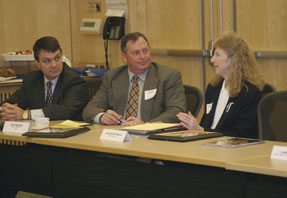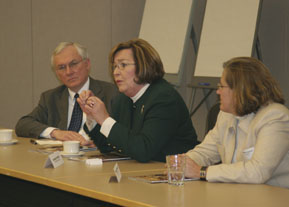The Uninsured
The question was raised as to just who the uninsured are and what can be done on a metro level to resolve the problems that they experience and the ones that they present.
“The majority are working poor,” noted Rex Archer, adding that a growing number of them are not exactly poor. Peter Yelorda described a sizeable cohort of the uninsured as 18-28 year olds with no obvious health problems and little sense of their own mortality.
As Steve Roling observed, Kaiser did a recent study in which they found the annual health costs for an average family of four to be about $10,800. This is a cost that would fully consume the income of a minimum wage worker. To help employers address this issue, Blue Cross Blue Shield has designed an initiative aimed at the small employer not now able to provide health benefits for its workers. “We are not addressing the indigent,” acknowledged Peter Yelorda, “but the working poor.”
Yelorda worried that the nation will “catch the problem on the back end” when the burden of providing increasingly expensive health care coverage will make American enterprise less than competitive in the international market. Already, he noted, health benefits add $1,500 to the cost of every General Motors auto, a cost that is beginning to weigh the company down. “When you have an employer asking for a national dialogue,” he added, “that gets the attention of insurers.”
Affirmed Rex Archer, “Employers will force the debate only when [insurance costs] become a trade issue.”
 Julie Welch of Meara, King & Co. believes that incentives for healthy employees should be paid into personal medical savings accounts. Bob Dunn and Joe Sweeney observe.
Julie Welch of Meara, King & Co. believes that incentives for healthy employees should be paid into personal medical savings accounts. Bob Dunn and Joe Sweeney observe.
State Solutions
The Kauffman Foundation’s Bob Litan questioned whether it was possible for a given state, Kansas or Missouri in particular, to craft a state-level solution to the problems of the indigent and the uninsured.
The participants weren’t optimistic. Rex Archer thought it possible only in states like Hawaii, which are isolated and self-contained.
Bill Bruning anticipates “just incremental change, playing around the edges.” He cited changes in the certificate of needs statutes as an example. Peter Yelorda saw little chance for states to affect behavioral issues like obesity. “There is an old saying,” he added wryly. “that Americans will do the right thing once they have tried everything else.”
As Steve Roling noted, however, Missouri has already passed legislation to end the Medicaid program as it currently exists by 2008. So changes will be made. Whereas it used to be hard to get waivers, that now is getting easier. “The Feds are looking to states to be innovators,” added Roling. Missouri’s role as a bellwether state means that people will be watching what the legislature does even more closely.
 Davoren Tempel of Children’s Mercy discusses the challenges associated with communications among various agencies. Terry Snapp and Michelle Sweeney observe.
Davoren Tempel of Children’s Mercy discusses the challenges associated with communications among various agencies. Terry Snapp and Michelle Sweeney observe.
Smoking Referendum
Rex Archer argued strongly that smoking was “the number one problem in our region.” He believes that if smoking were eliminated we would have more than enough hospitals and doctors to handle the region’s health needs.
Archer seemed to reflect the consensus of the group. Steve Roling noted that among the ballot amendments in the upcoming election is one that would raise the tax on tobacco, which would not only discourage use but which could also create revenue to be used for prevention. “I would invite all of us to be aware of that,” said Roling.
Bob Dunn was equally passionate on the subject. Noting that Fairway had decided to ban smoking in its restaurants, he urged that it be banned outright. “Civic leaders and the health community need to get involved,” he added.
On the subject of how smoking and obesity affect children, Brenda Sharpe pointed out at least “one small victory in Kansas.” There, the beverage association is policing itself on what it puts in vending machines in schools.
 KCMO Health Department Director Rex Archer promotes prevention as the key to managing increasing health costs. Archer is particularly adamant against smoking in public.
KCMO Health Department Director Rex Archer promotes prevention as the key to managing increasing health costs. Archer is particularly adamant against smoking in public.
Cooperation
When asked about her institution’s greatest challenge, Davoren Tempel of Children’s Mercy Hospital Foundation cited “communication between agencies,” specifically the sharing of goals and the sharing of roles. All participants agreed that in an era of increasingly scarce resources, cooperation among funding agencies and among recipients was crucial.
Larry Jacob affirmed that “more collaborations” were essential for the survival of the philanthropic health care mission. Part of the role of his foundation, he added, is to help make the funded agencies more capable of competing and collaborating.
Brenda Sharpe has witnessed some “tremendous experiences in collaboration.” Non-profits, from her perspective, are “really in a high-functioning flexible mode.” She sees them as quick acting and extremely responsive to challenges and opportunities. Indeed, she has known of some so nimble that they realized that their mission could best be accomplished by folding it fully or part into another agency—and proceeded to do so.